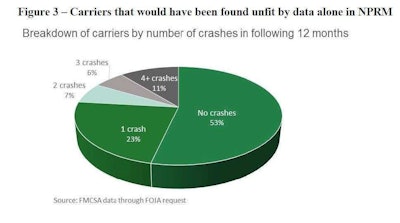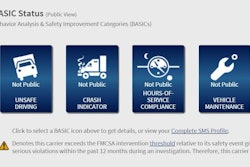 Chart pulled from TransAdvise’s public comment made on the Safety Fitness Determination rulemaking.
Chart pulled from TransAdvise’s public comment made on the Safety Fitness Determination rulemaking.New analysis published recently indicates that the agency’s January-published proposal to revamp the way it determines carriers’ fitness to operate could be plagued by the same “crash flaw” issue that’s plagued the larger Compliance, Safety, Accountability program from its 2011 onset.
Numbers obtained via a Freedom of Information Act request made by the Alliance for Safe, Efficient and Competitive Truck Transportation show that more than half (56 percent) of the carriers FMCSA said would have been deemed “Unfit” in 2011 under the inspection-based portions of the Safety Fitness Determination rule — and who remained in business for at least the next year — recorded zero crashes in that 12-month time span.
Perhaps even more concerning for owner-operators and small carriers, ASECTT’s Freedom of Information Act-obtained numbers show that 76 percent of carriers with five or fewer trucks, and who had been flagged Unfit to operate, recorded no crashes in the 12 months succeeding.
ASECTT obtained the data from FMCSA on May 4, according to a roughly 60-page comment filed by a coalition of carrier groups, including ASECTT, during the Safety Fitness Determination rule’s public comment period. Transportation research firm TransAdvise, which filed an affidavit as part of the coalition’s comments, performed the analysis for the coalition. ASECTT’s FOIA request, and the numbers handed over by FMCSA therefrom, only pertain to carriers that would have been found “Unfit” based on inspection data, rather than the several thousand carriers that would have been found Unfit in 2011 under the rule at large.
The numbers — and the questions they present about the proposed rule’s methodology — add to the mounting pressure the agency’s faced since publishing the proposed rule in January. The rule’s heavy use of data from the Compliance, Safety, Accountability Safety Measurement System’s BASICs violates both federal law and common sense, trucking industry groups have argued. Legislation has also been presented in the U.S. House to block the agency from continuing to work on the rule, pending an overhaul of the CSA program.
The public comment period for the rule ended May 23. CCJ explored some of the main arguments surrounding the rule earlier this week — click here to see that coverage. A one-month reply period is currently ongoing, too, until June 23. Click here to leave a reply comment.
The SFD rule would in short do away with the agency’s Satisfactory, Unsatisfactory and Conditional ratings, which are made during on-site compliance reviews. The SFD rule would replace those ratings with a simple “Unfit” designation; all other carriers would be presumed fit to operate. The rule also changes the way the agency can dole out such a rating, allowing it to use roadside inspection and violation data — rather than an on-site review — to tag a carrier as Unfit. Carriers failing two SMS BASICS would be hit with an automatic Unfit rating. Carriers failing one would be flagged for an investigation.
TransAdvise’s analysis of the agency’s January-presented data focuses on the 382 that would have been deemed “Unfit” based either wholly or in part on inspection-derived data.
Of those, 262 carriers failing two BASICs — causing them an “Unfit” determination — 211 remained operational for the next 12 months.
Of those 211, 113 recorded no crashes, despite the full group’s 8.28 crashes per 100 power units crash rate. Just five carriers of the 211 — 2.4 percent of the total — accounted for 27 percent of the group’s crashes in the next 12 months, according to the analysis. Also of the 211, 92 run five or fewer trucks, and 73 percent of those carriers (67) recorded no crashes in the next 12 months.
These trends were even more pronounced for the remaining 120 carriers who failed a BASIC and were then determined Unfit via an investigation. Of those carriers, 62 percent were not involved in a crash in the 12 months following the Unfit determination. For carriers running five or fewer trucks, 82 percent who were found Unfit recorded no crashes in the next 12 months.
See more coverage of the proposed Safety Fitness Determination rule — and the subsequent backlash — at the links below.












